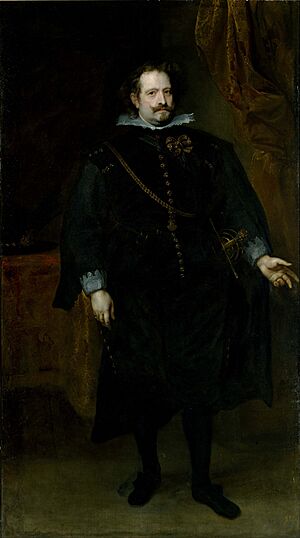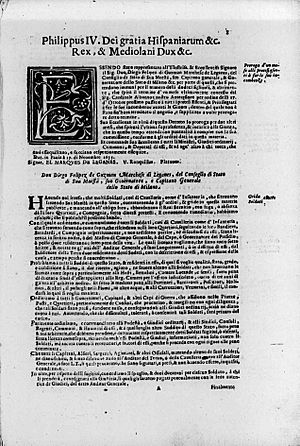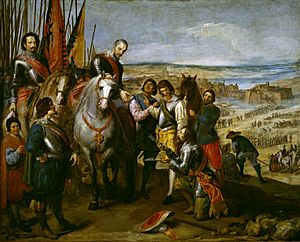Diego Felipez de Guzmán, 1st Marquess of Leganés facts for kids

Diego Mexía Felípez de Guzmán y Dávila, 1st Marquess of Leganés (1580–1655) was an important Spanish politician and army leader. He played a big role in Spain's government and military during the 17th century.
Contents
A Life of Service
Diego was born in 1580. He was the youngest son of the Marquess of Loriana. His aunt was Leonor de Guzmán, who was also the aunt of the Count-Duke of Olivares. Olivares later became a very powerful person in Spain.
Early Military Career
Starting in 1600, Diego spent over 20 years fighting in the Spanish Netherlands. He served Albert VII, Archduke of Austria, who was a ruler there. After the Archduke passed away, Diego went back to Spain.
Rise to Power
Back in Spain, his cousin Olivares had become the king's most trusted advisor. With Olivares' help, Diego quickly became very influential.
In 1626, Diego joined the State Council. This was an important group that advised the king. A year later, in 1627, he was given the title of Marquess of Leganés. In the same year, he married Polixena Spinola. She was the very wealthy daughter of a famous general named Ambrosio Spinola.
Important Missions
In 1627, Diego was sent back to Flanders. His job was to convince the Dutch government to accept Olivares' plan. This plan, called the Unión de Armas, asked them to pay for 12,000 extra soldiers.
On his way back, Diego and General Ambrosio Spinola visited the Siege of La Rochelle in France. They talked about who would rule the Duchy of Mantua. This discussion later led to a big conflict called the War of the Mantuan Succession.
After this mission, Diego held many important jobs in the Spanish Netherlands. These roles earned him the title of Grandee of Spain in 1634. This was a very high noble title.

Governor of Milan
On September 24, 1635, Diego was made Captain General and Governor of the Duchy of Milan. He soon became involved in wars. These included the Franco-Spanish War (1635) and the Piedmontese Civil War. He fought against France, Parma, Mantua, and Savoy.
He forced Odoardo Farnese, the Duke of Parma and Piacenza, to sign a peace treaty in 1637. He also stopped the French from taking the Valtellina region. Diego won some battles against Savoy.
In 1638, Diego conquered the cities of Breme and Vercelli. The next year, he started a big attack against Piedmont. He took many cities. However, he suffered a big loss near Casale. He also failed to capture Turin in the Siege of Turin (1640).
Later Years and Return to Spain
Diego was called back to Spain. In November 1641, he was put in charge of the army in Catalonia. His job was to push back French and Catalan troops during the Catalan Revolt.
He had some early successes defending Tarragona. But he lost a battle in Battle of Lerida (1642) in 1642. This made him lose favor with the king.
In 1645, Diego was given another chance. He was made the Viceroy of Catalonia. He successfully defended the city of Lérida in 1646. He stayed as viceroy until 1648.
Diego spent his final years in Italy. He was the president of the council of Italy.
Family Life
Diego first married Polixena Spinola. She passed away in 1639. They had two children:
- Gaspar Felípez de Guzmán y Spinola, who became the 2nd Marquess of Leganés. He was also governor of Oran and Viceroy of Valencia.
- Gaspar's son was Diego Dávila Mesía y Guzmán, 3rd Marquess of Leganés.
- Ambrosio Ignacio Mexía Felípez de Guzmán y Spinola (1632–1684). He was a teacher to Balthasar Charles, Prince of Asturias and later became an Archbishop.
Diego later married Juana Fernández de Córdoba y Rojas. She was the daughter of Luis Fernández de Córdoba, the 6th Duke of Sessa.
Art Collector
The Marquess of Leganés was also a very big art collector. He owned a huge number of paintings, about 1,330 in total! He was even painted by the famous artist Anthony van Dyck. This painting is now in the Banco Santander Foundation in Madrid.
See also
 In Spanish: Diego Mexía Felípez de Guzmán para niños
In Spanish: Diego Mexía Felípez de Guzmán para niños


